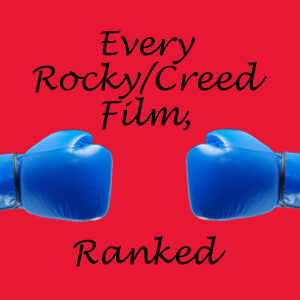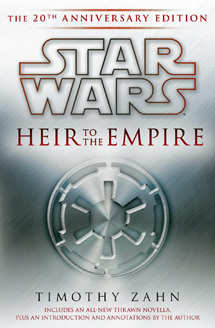Sometime in the late 1990s, I was at Paradox Comics in Fargo, N.D., talking with the proprietor about “Star Wars.” I mentioned Timothy Zahn’s novels, and he said, “To me, those have nothing to do with ‘Star Wars.’ “
I didn’t follow up on that — between his glass eye and my inability to pick up social cues, I figured the conversation was over and I took my leave; also, I was totally flabbergasted by such a viewpoint. I wish I had found out more about where he was coming from, because it’s such an unusual point of view among “Star Wars” fans. Was he merely a movie snob? Or did he really think Zahn’s inventions didn’t fit with “Star Wars?” As much as I love to be a hipster contrarian when pontificating about pop culture, I hold to the party line on this topic: I love Zahn’s “Star Wars” novels with the same reverence that a religious person loves their holy book. Or to put it more strongly — with the same reverence I love the original film trilogy.
I’ll get to why they are great in a bit, but first I have to tell the origin story of my love for 1991’s “Heir to the Empire,” known to fans of the “Star Wars” Expanded Universe as the Book That Started It All. People slightly older than me can tell their stories about waiting in line for “Star Wars” in 1977, having to extract their jaws from the gum-covered floor after the Star Destroyer passed over head, going back to the theater 47 more times that summer, blah, blah, blah. I can’t do that, but I’m not complaining, because I turned 13 in June 1991, the perfect age to be mesmerized by “Heir to the Empire.”
That year, my dad sold his “Superman” comic collection to Cosmic Comics in Lincoln, Neb. To get the best deal, part of the payment had to be accepted in store credit, so me and my younger sister benefited from the windfall. My sister snapped up some “Teenage Mutant Ninja Turtles” comics (a sweet deal for me, because I have since procured them for my collection) and I gobbled up a ton of vintage “Star Wars” toys.
Even after that, we still had some store credit to spend. I noticed “Heir to the Empire” on the shelf. The proprietor told us that they were re-introducing “Star Wars” as a book series. Also, I noticed issue No. 4 of “Dark Empire,” and the proprietor said they were also re-introducing “Star Wars” as a comic-book series. He gave us this scoop with an air of: “Interesting experiment to bring back ‘Star Wars’ — maybe it’ll be successful, maybe not.”
I got first crack at “Heir to the Empire,” although my dad would read it as soon as I was done. Up to that point in my life, the books that had excited me most were the novelization of “Teenage Mutant Ninja Turtles II: The Secret of the Ooze” and whatever the newest “Hardy Boys” entry was.

From 1977 through 1990 there were 10 “Star Wars” novels released (nowadays, there are about 10 per year): The three movie novelizations; “Splinter of the Mind’s Eye,” a Luke-and-Leia adventure by Alan Dean Foster; the Han Solo trilogy by Brian Daley and the Lando Calrissian trilogy by L. Neil Smith. I had all of them in my collection — and would eventually enjoy reading all of them, especially Daley’s work — but I had probably only read the movie novelizations by ’91.
I read “Heir” slowly, laying next to the air-conditioner vent in my bedroom and savoring every word. Still, I probably finished it in a couple of days; I probably read from morning till night, the way teens of the Aughts did when new “Harry Potter” books came out. When I finished, I wanted my dad to read it fast so he could also be up to speed with the lives of Luke, Han and Leia, but he said, no, he planned to savor it. Since then, I’ve always thought Zahn’s “Star Wars” novels deserve to be savored — they are something special.
Just the idea of it — the further adventures of Luke, Han and Leia — was amazing to behold. “Heir” has sometimes been criticized for starting slowly (it’s not structured at all like the three classic movies, which perhaps would’ve been Comic Book Guy’s complaint), but I marveled at Zahn’s expansion of the “Star Wars” universe. Our heroes now lived on Coruscant, a city-wide planet that was the heart of civilization. The Empire wasn’t what it used to be, but there was still a genius alien Grand Admiral named Thrawn out there. I experienced “Star Wars” words for the first time — tapcafe, turbolift, transparisteel, refresher — and they all sounded so natural. So did new worlds like Abregedo-rae, Myrkr, Obroa-skai, Bpfassh, Nkllon and Sluis Van (even if they weren’t exactly pronouncable).
When Luke arrived on Dagobah and revisited the Dark Side cave from “The Empire Strikes Back,” I was blown away. At this point in the novel, it becomes clear that Zahn isn’t just a sci-fi writer grafting his ideas onto George Lucas’s; Zahn loved “Star Wars” as much as the readers did. When he later took us to the Wookiee homeworld of Kashyyyk — a planet that always seemed like it should’ve been in the movies — that just sealed the deal.
I don’t know if Zahn and Lucas have ever met or even talked on the phone; I wouldn’t be surprised to hear they never have. Yet somehow, Zahn has held a privileged place in Lucas’ universe. Lucas kept the name “Coruscant,” and the idea where “The entire planet is one big city!” (as Ric Ollie told Anakin) for “Episode I.” Zahn’s idea of exploring the Force in more detail, and the exploration of galactic politics and the Skywalker family’s role in them, both presaged Lucas’ interest in those subjects.
Either through active reading or osmosis, Lucas got on the same page with Zahn. He hasn’t been so kind with other authors, blowing up carefully thought-out continuity seemingly on a whim in the prequels and especially the “Clone Wars” TV series. Michael Reeves killed off Even Piell post-“Episode III,” then “The Clone Wars” killed him off pre-“Episode III.” Karen Traviss worked out a complex and fascinating history for Mandalore and its people in her “Republic Commando” books; Lucas casually invented a new Mandalore and Mandalorians in “The Clone Wars.”
Even while partly inspiring (or predicting) the prequels, Zahn set the ground rules for “Star Wars” books, too. The idea of the Empire still being around after the Battle of Endor was a running theme of spin-off literature throughout the 1990s. Han and Leia’s twins, Jacen and Jaina, became main characters in many future novels. Luke and Mara became a couple as revered as Han and Leia (whom Zahn also paired as husband and wife). And Zahn’s “Star Wars” words were adopted by other authors, who have also made sure to keep “Star Wars” somewhat otherworldly, even though English and Basic are largely identical (characters drink “caf,” never coffee; and they wear a “tunic,” not a shirt).
People have tried to knock “Heir to the Empire” off the personal pedestal I’ve put in on. I once wrote a letter to “Star Wars” fanzine Blue Harvest about how Zahn’s novel resuscitated the franchise, and the editor argued that it wasn’t anything Zahn did, it was simply the existence of a new “Star Wars” product: We fans were there all along, we just needed something to talk about.
That’s a valid argument, but I wonder: What if “Heir to the Empire” and “Dark Empire” weren’t so well-received by fans? What if, after the half-decade of no “Star Wars” stories in the late-1980s, the franchise came back with something crappy? I’d argue that it could’ve fizzled out, and perhaps even soured Lucas on making the prequels.
I sometimes think about what that Fargo comic-shop guy and the Blue Harvest editor said. Am I overrating “Heir to the Empire,” the same way I overrate “Return of the Jedi” because I loved Ewoks as a kid? Have too many “Star Wars” fans put Zahn in a category with Lucas of “He can do no wrong” just because they were there first, and because we experienced those stories when we were younger and more naive?
The argument is fascinating, and one I’d love to engage in. But I think I’ll always be on the mainstream side of this one. Sure, I now see that Thrawn’s “genius” was more a trick of writing rather than anything that was deeply thought out. And when I read the abridged comic adaptation, I realized “Heir” needed the page count of a novel to be told properly; it’s not as media-versatile as the original trilogy. But, overall, “Heir” holds up beautifully.
I’ve also enjoyed the author’s eight “Star Wars” books since then, most recently “Choices of One,” where he continues to dig into the backstories of Thrawn and Mara. (Mara was the highest-ranking Expanded Universe character — at No. 20 overall — in a Star Wars Galaxy Magazine fan poll from about a decade ago; I’d love to see that poll given again today to learn where Zahn’s characters stand against EU newcomers like Ahsoka Tano, Asajj Ventress, Starkiller and Cade Skywalker).
For me, “Heir” is partly an innocent, childhood love, but it’s also a reasoned, adult love — like “Star Wars” in general. And I’m going to savor Zahn’s annotations in the 20th anniversary edition (to be released on Sept. 6) the same way I did the annotated screenplays of the original trilogy.
Thanks for everything, “Heir to the Empire.”

